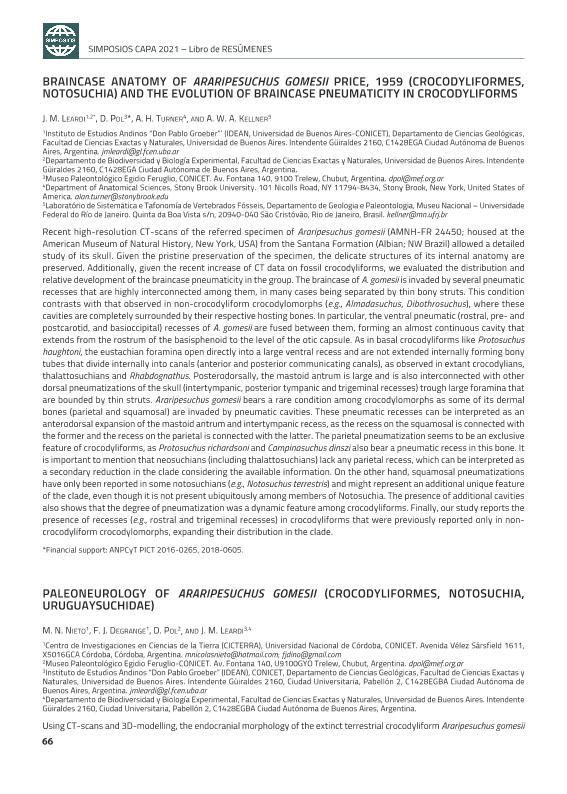Mostrar el registro sencillo del ítem
dc.contributor.author
Leardi, Juan Martín

dc.contributor.author
Pol, Diego

dc.contributor.author
Turner, Alan
dc.contributor.author
Kelner, Alexander
dc.date.available
2022-10-26T10:04:54Z
dc.date.issued
2021
dc.identifier.citation
Braincase anatomy of araripesuchus gomesii price, 1959 (crocodyliformes, notosuchia) and the evolution of braincase pneumaticity in crocodyliforms; XII Congreso de la Asociación Paleontológica Argentina; Buenos Aires; Argentina; 2021; 66-66
dc.identifier.issn
2469-0228
dc.identifier.uri
http://hdl.handle.net/11336/174860
dc.description.abstract
Recent high-resolution CT-scans of the referred specimen of Araripesuchus gomesii (AMNH-FR 24450; housed at the American Museum of Natural History, New york, USA) from the Santana Formation (Albian; NW Brazil) allowed a detailed study of its skull. Given the pristine preservation of the specimen, the delicate structures of its internal anatomy are preserved. Additionally, given the recent increase of CT data on fossil crocodyliforms, we evaluated the distribution and relative development of the braincase pneumaticity in the group. The braincase of A. gomesii is invaded by several pneumatic recesses that are highly interconnected among them, in many cases being separated by thin bony struts. This condition contrasts with that observed in non-crocodyliform crocodylomorphs (e.g., Almadasuchus, Dibothrosuchus), where these cavities are completely surrounded by their respective hosting bones. In particular, the ventral pneumatic (rostral, pre- and postcarotid, and basioccipital) recesses of A. gomesii are fused between them, forming an almost continuous cavity that extends from the rostrum of the basisphenoid to the level of the otic capsule. As in basal crocodyliforms like Protosuchus haughtoni, the eustachian foramina open directly into a large ventral recess and are not extended internally forming bony tubes that divide internally into canals (anterior and posterior communicating canals), as observed in extant crocodylians, thalattosuchians and Rhabdognathus. Posterodorsally, the mastoid antrum is large and is also interconnected with other dorsal pneumatizations of the skull (intertympanic, posterior tympanic and trigeminal recesses) trough large foramina that are bounded by thin struts. Araripesuchus gomesii bears a rare condition among crocodylomorphs as some of its dermal bones (parietal and squamosal) are invaded by pneumatic cavities. These pneumatic recesses can be interpreted as an anterodorsal expansion of the mastoid antrum and intertympanic recess, as the recess on the squamosal is connected with the former and the recess on the parietal is connected with the latter. The parietal pneumatization seems to be an exclusive feature of crocodyliforms, as Protosuchus richardsoni and Campinasuchus dinszi also bear a pneumatic recess in this bone. It is important to mention that neosuchians (including thalattosuchians) lack any parietal recess, which can be interpreted as a secondary reduction in the clade considering the available information. On the other hand, squamosal pneumatizations have only been reported in some notosuchians (e.g., Notosuchus terrestris) and might represent an additional unique feature of the clade, even though it is not present ubiquitously among members of Notosuchia. The presence of additional cavities also shows that the degree of pneumatization was a dynamic feature among crocodyliforms. Finally, our study reports the presence of recesses (e.g., rostral and trigeminal recesses) in crocodyliforms that were previously reported only in non- crocodyliform crocodylomorphs, expanding their distribution in the clade.
dc.format
application/pdf
dc.language.iso
eng
dc.publisher
Asociación Paleontológica Argentina

dc.rights
info:eu-repo/semantics/openAccess
dc.rights.uri
https://creativecommons.org/licenses/by-nc-sa/2.5/ar/
dc.subject
CROCODYLOMORPHA
dc.subject
CROCODYLIFORMES
dc.subject
PNEUMATICITY
dc.subject
EVOLUTION
dc.subject.classification
Paleontología

dc.subject.classification
Ciencias de la Tierra y relacionadas con el Medio Ambiente

dc.subject.classification
CIENCIAS NATURALES Y EXACTAS

dc.title
Braincase anatomy of araripesuchus gomesii price, 1959 (crocodyliformes, notosuchia) and the evolution of braincase pneumaticity in crocodyliforms
dc.type
info:eu-repo/semantics/publishedVersion
dc.type
info:eu-repo/semantics/conferenceObject
dc.type
info:ar-repo/semantics/documento de conferencia
dc.date.updated
2022-09-27T10:46:31Z
dc.journal.pagination
66-66
dc.journal.pais
Argentina

dc.journal.ciudad
Buenos Aires
dc.description.fil
Fil: Leardi, Juan Martín. Consejo Nacional de Investigaciones Científicas y Técnicas. Oficina de Coordinación Administrativa Ciudad Universitaria. Instituto de Estudios Andinos "Don Pablo Groeber". Universidad de Buenos Aires. Facultad de Ciencias Exactas y Naturales. Instituto de Estudios Andinos "Don Pablo Groeber"; Argentina
dc.description.fil
Fil: Pol, Diego. Museo Paleontológico Egidio Feruglio; Argentina. Consejo Nacional de Investigaciones Científicas y Técnicas; Argentina
dc.description.fil
Fil: Turner, Alan. Stony Brook University ; State University Of New York;
dc.description.fil
Fil: Kelner, Alexander. Universidade Federal Do Rio de Janeiro. Museu Nacional; Brasil
dc.relation.alternativeid
info:eu-repo/semantics/altIdentifier/url/https://www.apaleontologica.org.ar/wp-content/uploads/2022/02/XII-CAPA-Libro-de-Resu%CC%81menes-2021.pdf
dc.conicet.rol
Autor

dc.conicet.rol
Autor

dc.conicet.rol
Autor

dc.conicet.rol
Autor

dc.coverage
Internacional
dc.type.subtype
Congreso
dc.description.nombreEvento
XII Congreso de la Asociación Paleontológica Argentina
dc.date.evento
2021-11-23
dc.description.ciudadEvento
Buenos Aires
dc.description.paisEvento
Argentina

dc.type.publicacion
Journal
dc.description.institucionOrganizadora
Asociación Paleontológica Argentina
dc.source.revista
Publicación Electrónica de la Asociación Paleontológica Argentina
dc.date.eventoHasta
2021-11-26
dc.type
Congreso
Archivos asociados
